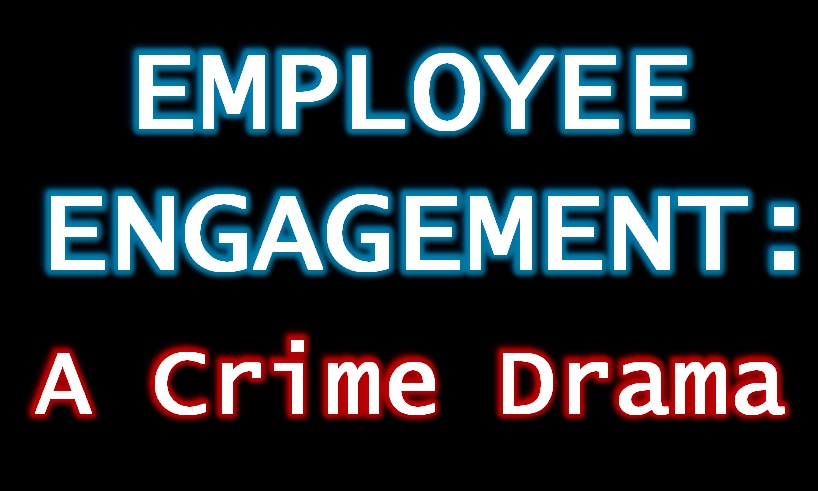
If you think about it, employee engagement is an ongoing crime drama. Cue the Law & Order’s “The Clang.”1
Unfortunately, it’s not a show we just steam/watch on TV; it is a reality for far too many people.
The Opening
In businesses’ war on disengagement, the worst offenders are pursued by Employee Engagement Operatives. These are their stories.2
The Crime
There is a thief that is a known associate of 50-70% of all employees. Alias: “Disengagement.” According to the latest intelligence, this thief costs the US Economy approximately half a trillion dollars ($550 billion) in lost productivity each year.3
The Good Guys (and Women)
Our drama offers the usual cast of characters: the citizen, the cop, and the coroner. In our case, each of these characters is an Employee Engagement Operative. They help companies and their employees succeed by identifying and eliminating “Disengagement” in the workplace.
The Citizen – The root cause of disengagement is related to the unmet needs of the individual employee: They are micro-managed and thus lack the autonomy they desire in their work; They aren’t given learning and development opportunities to maintain and grow their skills; They aren’t recognized and rewarded for the work they do; etc. Citizens want to make a difference and have an impact. They must take responsibility for their own engagement and hold their managers and company leaders to higher standards.
The Cop – A cop is a person who walks the beat and patrols the area every day. They protect the engaged and actively work to discourage “Disengagement” from coming around. Sometimes they are the front line defense and other times they infiltrate the organization to root out “Disengagement’s” accomplices. Cops feel a calling to “protect and serve.”
The Coroner – Even though the coroner enters the scene post-mortem, they have an important mission to investigate and identify the cause of “Disengagement’s” actions. Coroners are frequently called in when change management programs fail. Their work helps us avoid similar outcomes in the future.
Together, the citizen, the cop, and the coroner all play an active role in bringing “Disengagement” to justice.
The Investigation
Many reports have been written on employee engagement cases. Gallup’s State of the American Workplace Survey4 noted that 70% of all employees are either “Not Engaged” (52%) or “Actively Disengaged” (18%) and only 30% are “Engaged.”
When these reports are taken as a whole, there are four areas to examine closer. We can weaken “Disengagement” by focusing on the employee-manager relationship, recognition and rewards, growth and development, and advancement opportunities.
The Evidence
Employee –Manger Relationship: “Managers account for 70% of variance in employee engagement.”5
Recognition and Rewards: “Organizations with savvy recognition practices are 12x more likely to have strong business outcomes.” 6
Growth and Development: “Quantum Workplace 2016 Employee Engagement Trend Report – One of the top drivers of engagement is seeing professional growth and career development opportunities in the organization.” 7
Advancement Opportunities: “59% of employees surveyed believe that their manager is responsible for helping them achieve their career goals inside the organization.” 8
The Trial
“Disengagement” is shifty and has yet to be captured. For now, it is the accomplices of “Disengagement” who are on trial.
Defendant #1: Company leaders who have failed to implement effective employee engagement processes within their companies. Typically, they claim to engage their employees through various programs such as corporate giving campaigns and community volunteerism events. While these types of programs give employees an opportunity to make a difference, they aren’t major determinants of engagement or retention. In fact, I would argue that these programs are self-serving in that they allow the company to collect money and volunteer hours to claim as their own when, in fact, they only facilitated the process.
Defendant #2: Direct managers who lack the necessary managerial qualities. These managers can be found at the extremes of the manager spectrum. On one side, they are command and control focused, micro-managing every detail, squashing ideas, refusing to develop their direct reports, and holding people back from greater opportunities. On the other end, actively disengaged managers have been known to:
- Intentionally impede the progress and promotion of direct reports
- Slow or stall the hiring process
- Work against change management projects
- Hold back information needed by their direct reports and superiors
The Outcome
In some companies, the dispute was settled before it went to trial, i.e., startups. Company leaders and direct managers are held accountable to identify and eliminate “Disengagement” in their workplaces.
In most others, the trial is just getting underway. Motions are being filed; delay tactics are being used. The defendants’ goal is to hold out until the witnesses give up and leave the company. Then, they’ll use those former employees as scapegoats to mask the true identity of the perpetrator.
Luckily, time is running out on these tactics. As more and more companies begin to realize that “Disengagement” has infiltrated their workplaces, they will have to start placing an increased importance on developing methods to drive the thief out. For now, the case remains open. The end result is a cliffhanger.
“The Chang” again…9
No rest for the weary.The next episode is underway. It seems a new crime report involving “Disengagement” was just filed. To achieve justice in the ongoing case against “Disengagement,” you must assume the roles of the citizen, cop, and coroner. Are you on the beat?
What are your thoughts on employee engagement as a crime drama? Between the citizen, the cop, and the coroner, which are you most like?
1 “Law And Order Sound | Free Sound Clips.” Orange Free Sounds. Orange Free Sounds, 06 May 2015. Web. 31 Aug. 2016.
2 “What Are the Opening Lines to All Law and Orders’ Starts When the First Black Title Screen Appears?” Yahoo! Answers. Yahoo!, n.d. Web. 31 Aug. 2016.
3 “State of the American Workplace.” Gallup.com. Gallup, Inc. Web. 31 Aug. 2016. <http://www.gallup.com/strategicconsulting/163007/state-american-workplace.aspx>.
4 Ibid.
5 Beck, Randall, and James Harter. “Managers Account for 70% of Variance in Employee Engagement.” Gallup.com. Gallup, Inc., 2 Apr. 2015. Web. 31 Aug. 2016
6 “6 Things You Should Know About Each Employee.” Infographic: 6 Things You Should Know About Every Employee. PeopleFluent, Inc., n.d. Web. 31 Aug. 2016.
7 Huhman, Heather. “This Is How Employee Engagement Is Changing [INFOGRAPHIC].” DigialistMagazine. SAP SE, 31 May 2016. Web. 31 Aug. 2016.
8 “Talk the Talk: How Ongoing Career Conversations Drive Business Success [Infographic].” Right. Right Management, 2016. Web. 31 Aug. 2016.
9 “Law And Order Sound | Free Sound Clips.” Orange Free Sounds. Orange Free Sounds, 06 May 2015. Web. 31 Aug. 2016.
Let’s Engage!
I’m Agent in Engagement Simpson…Gregory F Simpson.
Employee engagement is a critical mission. I hope I can count on your help! Subscribe to the RSS Feed to receive the latest intelligence/insights and/or register to make entries in the comments log.
 You can follow me @agtinengagement.
You can follow me @agtinengagement.
Email me at g…@a…t.com.
Connect via LinkedIn at LinkedIn.com/in/GregoryFSimpson.
Learn more about me at gregoryfsimpson.com.
P.S. First contact? Welcome to the Agent In Engagement community. Explore and join fellow employee engagement operatives in targeting a known thief – alias: Disengagement. Together we can bring this thief to justice and make the world a better place for all companies and their employees.
Other recent Agent in Engagement data/reports by Agent Gregory F Simpson:
- Employee Engagement Intelligence Briefing: 2016.08.22 – 2016.08.26
- Veteran Operative Employee Engagement Insights: 08.22 – 2016.08.26
- [Book Summary] O Great One!: A Little Story About the Awesome Power of Recognition
- [Book Summary] Engaging the Hearts and Minds of Your Employees: How to Ignite Passionate Performance for Better Business Results by Lee J. Cohan, Ph.D.
- 2016 TED Talks Relevant to Employee Engagement – Part 1
- The Gift of an Inquiring Mind
- Engage in a Family Friendly Work Culture
